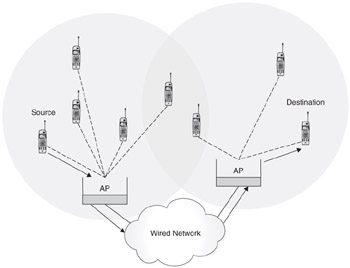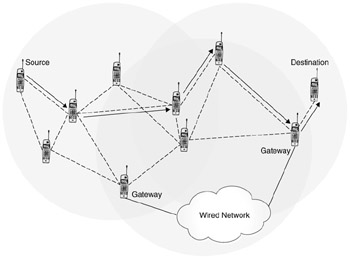802.11 Wireless LANs
The 802.11 series of standards have made wireless network connectivity accessible for a great many people. Wireless LANs provide an alternative to wired Ethernet, and offer many advantages, particularly in terms of ease of use and ubiquity. Wireless LANs can be found in many workplaces and public areas-for instance, a great many airports make a WLAN available to people awaiting flights.
Wireless LANs fall into two categories: infrastructure-based and ad hoc. Infrastructure WLANs rely on access points (APs) to provide a connection to a wired LAN, as well as a central point for communication. Public wireless hotspots, such as those at coffee shops and airports, are typically infrastructure WLANs. Figure 7.1 shows a sample infrastructure-based WLAN.

Figure 7.1: An infrastructure WLAN relies on access points.
An access point in this configuration performs functions that are similar to a wired Ethernet switch with a wireless link in place of a cable; both systems use hierarchical routing. Wired Ethernet and WLANs can be used together because they employ the same MAC address scheme. An access point can act as an IP router, which is necessary in places where Ethernet does not provide the wired link; many access points also act as network address translation (NAT) devices, which are common in home WLANs.
Ad hoc networks do not rely on the existence of infrastructure; each mobile station is able to communicate with peers directly, and messages can be forwarded to a destination that is not directly reachable. An ad hoc WLAN can route traffic to the Internet or any other network through the use of gateway nodes that are attached to both the wired and access point network.
Ad hoc networks rely on routing protocols to enable message forwarding (see Figure 7.2). Where a connection to the Internet is required, gateway nodes are able to route messages destined for the Internet. There are too many different routing protocols for ad hoc networks to summarize them all effectively here. This book simply assumes that they achieve their goal and that a packet can be routed using a path that minimizes the number of hops and the total distance in some fashion.

Figure 7.2: Participants in an ad hoc network are active in routing messages.
The multiple paths through an ad hoc network make it very robust in the presence of failures. This, combined with the fact that ad hoc networks do not rely on infrastructure, means they have a number of applications. Ad hoc networks can also provide good network coverage without the same infrastructure requirements as a network utilizing access points. Each access point can provide service to a limited number of stations in an area, whereas ad hoc networks can scale to relatively high densities.
The primary focus of this section is on the use of ad hoc networks for wireless mesh networks. Wireless mesh networks are often used to provide cost-effective Internet connectivity in residential areas, business precincts, and/or areas where people might congregate.
Wireless mesh networks that are used for residential Internet access have a number of properties that can be exploited to simplify or optimize location determination. The wireless nodes generally remain stationary and the access network provider often has some form of preexisting relationship with each of the network users. Network properties that affect location, like the network topology, remain static over time in these networks. Therefore, location in these networks is easier to manage over time and locations can usually be given by a residential civic address with relative reliability. Automatic location determination methods can, in some cases, be kept for secondary roles, such as to assist in network maintenance and troubleshooting, or to provide a check on a statically mapped location.
In a more dynamic mesh network, such as those that are used for public places, location determination is complicated by more mobile wireless nodes. Location determination in the more fluid mesh network is additionally challenging. Automatic location determination becomes imperative in these networks.
EAN: 2147483647
Pages: 129